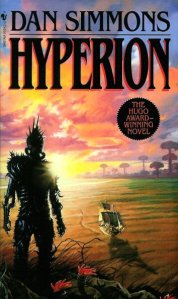
Ah, good old space opera.
I’d thought that I’d gotten thoroughly sick of space opera because so much of it is made out of recycled material. The issue of FTL travel irks me, too. But it turns out with Hyperion by Dan Simmons, that if you do space opera well enough, it’s still quite enjoyable.
Hyperion does use recycled material. But instead of trying to file the serial numbers off of the materials Simmons got his ideas from, he decided to go whole hog the other way and see just how many references to other stuff he can cram into one book.
This book’s Galactic Empire has a backwater planet called Hyperion, home to a mysterious killing machine called the Shrike. Legend has it that if a prime number of people make a pilgrimage to see the Shrike, it will grant one of them a wish and slaughter the rest. The book follows seven people on what may be the last pilgrimage ever as they board a spaceship headed for Hyperion. On the way, they decide to take turns sharing their reasons for going. Sound familiar? It’s The Canterbury Tales in space.
What I like about the book is that Simmons turned all the material drawn from other works into an artistic statement. Ever since Earth accidentally got swallowed up by a black hole (the Fall of Rome in space), human culture has failed to progress. They can’t do anything but recycle our own popular culture. Their society’s stuck in a Space Middle Ages.
It’s fun to pick out the references. The Ousters are Space Huns. Our pilgrimage party includes a Space Templar and a Space Jesuit. The Consul’s tale is Romeo and Juliet in space. Brawne Lamia’s tale manages to be simultaneously private detective noir in space and a story about Mary Magdalene with Robot Christ.
Not to be outdone with the religious references, Simmons also includes Fehdman Kassad, a Space Muslim. Maybe in 1989 when this book was published, Islam wasn’t as sensitive a topic as it is now, but Kassad still starts life as a street fighter, rises through the ranks of military academy, and then earns the title “The Butcher of Bressia.” Awkward.
On the other hand, I think Simmons did a great job with Sol Weintraub. He could very easily have come across like this. Instead, he’s a fully rounded character who’s being forced to relive the story of Abraham. Sol’s one of my favorite characters, second only to Brawne.
And about that pesky FTL travel: Simmons acknowledges that these characters travel at relativistic speeds and they actually have to face the consequences of the time dilation. Good work, sir.
If you’ve got a background in the classics and you like spec fic, you’d find this book fun.
 I picked up this book because I’d read Hyperion and I wanted to find out what happened to all of the characters. Sadly, I was disappointed.
I picked up this book because I’d read Hyperion and I wanted to find out what happened to all of the characters. Sadly, I was disappointed.

